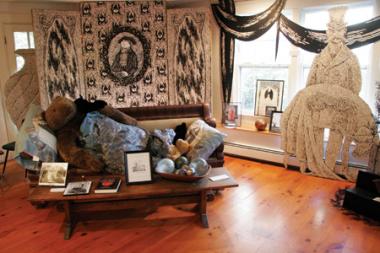The Cape certainly has its summer splendors—massive crowds, blazing sun and frigid water—but to limit a visit to the most-traveled season is a mistake. Go after Labor Day and Massachusetts’ flamboyant flexing bicep is a much calmer place. The sun’s a softer presence, and the beaches are almost deserted. Cool night breezes make it a comfortable, contemplative place to be.
Even that doesn’t have to be the end of the story. Heading Capeward even in midwinter has its share of pleasures. Solitary beach walks, though they don’t involve sand between the toes, make the slate ocean seem yet more of a presence, blowing in with the weight of hundreds of years of maritime history. It’s much easier to imagine whaling ships in the distance, heading out of New Bedford and around the Cape en route to Greenland.
It’s also a great time to uncover the area’s plentiful indoor treasures, from fine dining to endless bookstores where an hour’s leisurely browsing yields surprising finds. When I last visited the Cape, I discovered one of those small-scale indoor surprises that make it more than just a bunch of beaches and clam shacks. At an unassuming intersection on Route 6A in Yarmouth Port, map in my hand, I looked right, and there, though I’d passed it a dozen times and never noticed it before, was the house of one of my heroes: Edward Gorey.
I love Gorey’s weird antiquarian visual sense, his passion for a comical Edwardian floridity of language. A lot of folks know Gorey best for his Gashlycrumb Tinies, an abecedary of children meeting horrible fates (“J is for James who took lye by mistake”), or the animated sequence that opens PBS’ Masterpiece Mystery. It’s easy to mistake his black-and-white drawings, stuffed full of gentlemen in enormous coats, worried children and prim ladies, for the work of a British artist circa 1920.
But Gorey was in fact American, and died in 2000. His tremendous output is a unique body of work in which the surreal and the old-fashioned mingle to create something at once poignant and funny. Though he’s often spoken of as an illustrator, he was a wicked wordsmith, a careful crafter of phrases that quietly engage the weirdness of language: “Yesterday it did not seem as if today it would be raining.”
Gorey dubbed his house, at 8 Strawberry Lane, Elephant House. It doesn’t appear particularly elephantine, and is a large-ish house of a sort often spotted on the Cape. It’s now the Edward Gorey Museum. I don’t know precisely what I expected—an Edwardian mansion? A collection of oversized urns? But inside I found a small central space stuffed to the gills with ephemera and the aesthetically pleasing objects which, the guide explained, Gorey collected with something near obsession, visiting tag sales and antique shops with an eye for colored bottles, books, dolls, gewgaws and gimcracks of all sorts. Gorey’s favored outfit—including, most notably, long fur coat and tennis shoes—resides behind glass. It’s a strange shrine, and one that belies a surprising fact: central to the mission of the Gorey Museum is animal welfare.
The whole place has that undersized charm that affects most everything on the Cape. It seems a fitting hideaway for a man of unusual pastimes; surreal literary bent or no, Gorey apparently had a passion for soap operas and even TV advertisements, which he consumed while sewing together stuffed creations of his own design, including a particularly fetching batlike creature which shows up in his work.
The museum’s few rooms bear longer than usual contemplation. They hide all sorts of interesting things, much like an old-fashioned “wunderkammer,” or cabinet of curiosities. Getting a sense of who Gorey really was is more a slow accrual than a trumpet blast. Adding to the entertainment are the unfortunate children of The Gashlycrumb Tinies, who, in miniature black and white cutouts, meet their fates all over the Gorey House—one crawls under the rug in the main room on his way to a woolly smothering. Another tumbles down the stairs. Visitors receive a pencil and a card listing all 26, with check boxes for when each has been discovered. The very friendly staff helps make the most of a visit, and offers a large array of Gorey merchandise, some of which is often quite hard to find elsewhere.
Hidden away on the off-limits second floor is Gorey’s studio. Here, too, Gorey defied expectation. No grand room of vaulted ceiling and abundant light awaited. He worked instead in a space not much bigger than a walk-in closet. Clearly he was a man of mental interiors.
Somehow visiting Elephant House made Gorey the man seem prosaic, but in a good way. It seemed right that the creator of a distinctive universe overflowing with dark humor and collisions of charm and morbidity should reside in a comfortable nook, looking out on a little green at the meeting of two roads. It’s the sort of place that’s hard to notice in the bustle of the midsummer Cape, but just the kind of pleasure that’s great to indulge when the cottages shut their windows for the cold season.”
The Boston Athenaeum will present an Edward Gorey exhibition beginning Feb. 9. The Edward Gorey House is open April through December.



